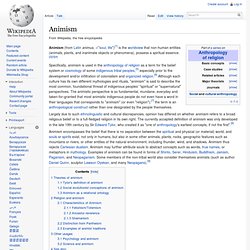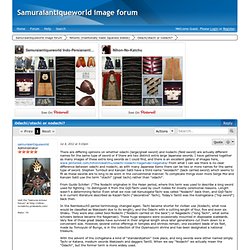

Sprite (creature) Significado dos Nomes - NOMES Germanicos. Significados dos nomes e origem do nome, nomes indigenas,nomes biblicos,nomes latinos,nomes indianos,nomes japoneses,nomes em ingles,significado do nome bebê com numerologia e tarot grátis.

VHSGIFS. GLITCH-EVCORE. I AM THAT. 12 dicas para escritores iniciantes por George R. R. Martin. A época dessa entrevista em Novembro de 2013, George R.R.

Martin esteve em Sydney no Opera House, para comentar mais uma vez sobre As Crônicas de Gelo e Fogo e aproveitou para dar algumas dicas para quem quer se aventurar pela escrita de fantasia, baseado em sua própria experiência. Mesclamos isso a algumas dicas tiradas da seção de perguntas frequentes do site oficial de Martin. Animism. Specifically, animism is used in the anthropology of religion as a term for the belief system or cosmology of some indigenous tribal peoples,[5] especially prior to the development and/or infiltration of colonialism and organized religion.[6] Although each culture has its own different mythologies and rituals, "animism" is said to describe the most common, foundational thread of indigenous peoples' "spiritual" or "supernatural" perspectives.

The animistic perspective is so fundamental, mundane, everyday and taken-for-granted that most animistic indigenous people do not even have a word in their languages that corresponds to "animism" (or even "religion");[7] the term is an anthropological construct rather than one designated by the people themselves. Largely due to such ethnolinguistic and cultural discrepancies, opinion has differed on whether animism refers to a broad religious belief or to a full-fledged religion in its own right. Theories of animism[edit] Tartarus. Greek mythology[edit] In Greek mythology, Tartarus is both a deity and a place in the underworld.

In ancient Orphic sources and in the mystery schools, Tartarus is also the unbounded first-existing entity from which the Light and the cosmos are born. As for the place, Hesiod asserts that a bronze anvil falling from heaven would fall nine days before it reached the earth. The anvil would take nine more days to fall from earth to Tartarus.[3] In The Iliad (c. 700 BC), Zeus asserts that Tartarus is "as far beneath Hades as heaven is high above the earth. " Originally, Tartarus was used only to confine dangers to the gods of Olympus. Spirit. Samuraiantiqueworld image forum. There are differing opinions on whether odachi (large/great sword) and nodachi (field sword) are actually different names for the same type of sword or if there are two distinct extra large Japanese swords.

I have gathered together as many images of these extra long swords as I could find, and there is an excellent gallery of images here, www.pinterest.com/nihonnokatchu/odachi-nodachi-nagamaki-naganata/ From what I can see there is no clear difference between odachi and nodachi, as with many Japanese items there can be two or more names for the same type of sword. Stephen Turnbull and Kanzan Satō have a third name "seoidachi" (back carried sword) which seems to fit as these swords are to long to be worn in the conventional manner. To complicate things even more Serge Mol and Kanzan Satō use the term "otachi" (great tachi) rather than "odachi". In the Nambokuchô period terminology changed again. Handgun holster. A handgun holster is a device used to hold or restrict the undesired movement of a handgun, most commonly in a location where it can be easily withdrawn for immediate use.

Function[edit] Holsters are generally designed to offer protection to the handgun, secure its retention, and provide ready access to it. The need for ready access is often at odds with the need for security and protection, so the user must consider the individual's needs. Choosing the right balance can be very important, especially in the case of a defensive weapon holster, where failure to access the weapon quickly or damage or loss of the weapon due to insufficient retention or protection could result in serious injury or death to the user.
Holsters are generally designed to be used with one hand, allowing the handgun to be removed and/or replaced with the same hand. Masamune. Masamune Portrait Masamune (正宗?)

, also known as Gorō Nyūdō Masamune (五郎入道正宗? , Priest Gorō Masamune, c.1264–1343 AD),[1] is widely recognized as Japan's greatest swordsmith. He created swords and daggers, known in Japanese as tachi and tantō respectively, in the Soshu tradition. Muramasa. Muramasa Sengo (千子 村正, Sengo Muramasa?)

Was a famous swordsmith who founded the Muramasa school and lived during the Muromachi period (14th to 16th centuries) in Japan. Oscar Ratti and Adele Westbrook said that Muramasa "was a most skillful smith but a violent and ill-balanced mind verging on madness, that was supposed to have passed into his blades. They were popularly believed to hunger for blood and to impel their warrior to commit murder or suicide. "[1] The school of sword-making at Ise province was famous for the extraordinary sharpness of their blades. Muramasa's swords fell out of favor with the Japanese government when Tokugawa Ieyasu became shogun, establishing the Tokugawa Shogunate, in 1603.
Battōjutsu. Battōjutsu (抜刀術, battō-jutsu?)

("the craft of drawing out the sword") is an old term for iaijutsu. Battōjutsu is often used interchangeably with the terms iaijutsu and battō.[1] Generally, battōjutsu is practiced as a part of a classical ryu and is closely integrated with the tradition of kenjutsu and is practice with the live-blade, katana, often as simply the sole, kata.[1] The training is for combative effectiveness,[2] through factors such as distancing, timing and targeting. As such, battōjutsu is not intended for sportslike or "spiritual" purposes as are modern budo like iaido and kendo.[3] List of schools[edit] Old school: Modern schools developed after the beginning of the Edo era: Matsumata-ryū, founded in 1750 by Matsumata KeisukeToyama-ryū, founded in 1925 by Nakamura Taisaburo[4]Nakamura-ryū, founded by Nakamura Taizaburō in the mid-20th century, who had previously taught Toyama-ryū[5] References[edit] Iaido. Iaido (居合道, Iaidō?)

, abbreviated with iai (居合?) ,[3] is a modern Japanese martial art/sport.[4] Practitioners of iaido are often referred to as iaidoka.[8] Origins of the name[edit] Haruna Matsuo sensei (1925-2002) demonstrating Muso Jikiden Eishin Ryu kata Ukenagashi The term 'iaido' appear in 1932 and consists of the kanji characters 居合道.[9][10] The origin of the first two characters, iai (居合?) Last character, 道 is generally translated into English as the way. Japanese sword mountings. Two antique koshirae, katana (top), wakizashi (bottom), in the form of a daisho (matched set) A daisho set of Japanese sword storage mounts (shirasaya) for katana (top) and wakizashi (bottom).
A diagram of a katana and koshirae with components identified.